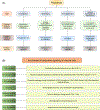Polyamines: Key Players in Immunometabolism and Immune Regulation
- PMID: 39717382
- PMCID: PMC11666123
- DOI: 10.33696/immunology.6.206
Polyamines: Key Players in Immunometabolism and Immune Regulation
Abstract
Polyamines are small organic molecules ubiquitously present in all living organisms and function as crucial regulators of biological processes ranging from fundamental cellular metabolism to immune regulation. Dysregulation of polyamine metabolism has been implicated in numerous diseases, including neurodegenerative disorders, inflammatory conditions, autoimmune diseases, and cancer. This review provides an overview of pathophysiology of these conditions, highlighting polyamines' role in immunometabolic alterations in the context of immune regulation. Exploring the intricate mechanisms of polyamine metabolism holds promise for advancing our understanding of disease processes and developing potential innovative therapeutic interventions.
Keywords: Cancer; HIV; Immune regulation; Immunometabolism; Polyamines; Tumorigenesis.
Conflict of interest statement
Conflict of Interest The authors declare that they have no conflict of interest.
Figures


Similar articles
-
Polyamine Immunometabolism: Central Regulators of Inflammation, Cancer and Autoimmunity.Cells. 2022 Mar 5;11(5):896. doi: 10.3390/cells11050896. Cells. 2022. PMID: 35269518 Free PMC article. Review.
-
Unveiling the growing significance of metabolism in modulating immune cell function: exploring mechanisms and implications; a review.Ann Med Surg (Lond). 2023 Sep 13;85(11):5511-5522. doi: 10.1097/MS9.0000000000001308. eCollection 2023 Nov. Ann Med Surg (Lond). 2023. PMID: 37915697 Free PMC article.
-
The role of polyamines in gastric cancer.Oncogene. 2021 Jul;40(26):4399-4412. doi: 10.1038/s41388-021-01862-x. Epub 2021 Jun 9. Oncogene. 2021. PMID: 34108618 Free PMC article. Review.
-
Translational and post-translational regulation of polyamine metabolic enzymes in plants.J Biotechnol. 2022 Jan 20;344:1-10. doi: 10.1016/j.jbiotec.2021.12.004. Epub 2021 Dec 14. J Biotechnol. 2022. PMID: 34915092 Review.
-
Polyamine Homeostasis in Development and Disease.Med Sci (Basel). 2021 May 13;9(2):28. doi: 10.3390/medsci9020028. Med Sci (Basel). 2021. PMID: 34068137 Free PMC article. Review.
Cited by
-
Heterogeneity in polyamine metabolism dictates prognosis and immune checkpoint blockade response in hepatocellular carcinoma.Front Immunol. 2025 Feb 6;16:1516332. doi: 10.3389/fimmu.2025.1516332. eCollection 2025. Front Immunol. 2025. PMID: 39981249 Free PMC article.
-
Multi-omics identification of a polyamine metabolism related signature for hepatocellular carcinoma and revealing tumor microenvironment characteristics.Front Immunol. 2025 Apr 22;16:1570378. doi: 10.3389/fimmu.2025.1570378. eCollection 2025. Front Immunol. 2025. PMID: 40330470 Free PMC article.
-
Plasma Metabolic Profiles of Chronic and Recurrent Uveitis Treated by Artesunate in Lewis Rats.Biomedicines. 2025 Mar 28;13(4):821. doi: 10.3390/biomedicines13040821. Biomedicines. 2025. PMID: 40299394 Free PMC article.
-
The role of colonic microbiota amino acid metabolism in gut health regulation.Cell Insight. 2025 Jan 10;4(2):100227. doi: 10.1016/j.cellin.2025.100227. eCollection 2025 Apr. Cell Insight. 2025. PMID: 39926315 Free PMC article. Review.
References
Grants and funding
LinkOut - more resources
Full Text Sources
